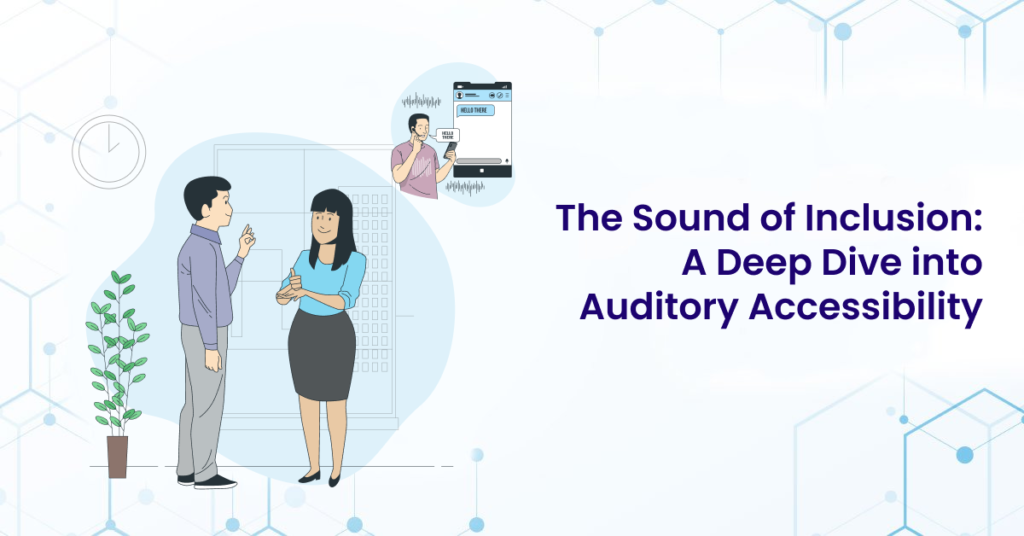In today’s digital age, accessibility is not just a buzzword; it’s a fundamental aspect of creating an inclusive online environment. While much attention has been given to visual accessibility, such as screen readers and alt text for images, auditory accessibility is equally vital yet often overlooked. In this blog, we’ll explore the significance of auditory accessibility, its challenges, and how businesses and content creators can ensure everyone has equal access to sound-based information.
Understanding Auditory Accessibility
Auditory accessibility refers to making digital content perceivable and understandable to individuals with hearing impairments or other auditory disabilities. This encompasses various aspects, including providing captions for videos, transcripts for podcasts, and audio descriptions for multimedia content.
The Importance of Auditory Accessibility
Imagine watching a video without sound or trying to follow a podcast without captions. For individuals with hearing impairments, this is a daily reality. By ensuring auditory accessibility, businesses and content creators can include everyone in their audience, regardless of their hearing abilities. It’s not just about compliance with accessibility standards, but about fostering inclusivity and diversity.
Challenges in Auditory Accessibility
Despite its importance, achieving auditory accessibility comes with its challenges. One significant hurdle is the lack of awareness among content creators and businesses about the needs of individuals with hearing impairments. Additionally, implementing auditory accessibility solutions requires time, resources, and specialized knowledge, which may deter some organizations from prioritizing it. Accessibility professionals can help make your digital assets inclusive, as they are well-versed in accessibility principles and standards, and can also streamline the process, saving both resources and time.
Solutions for Auditory Accessibility
Fortunately, several solutions exist to address auditory accessibility challenges:
- Captioning and Subtitling: Adding captions or subtitles to videos ensures that individuals with hearing impairments can follow along with the dialogue or narration. Automatic captioning tools are available, but manual review and editing may be necessary for accuracy.
- Transcripts: Providing transcripts for audio content such as podcasts allows individuals to read along with the spoken words. Transcripts are also beneficial for search engine optimization (SEO) and can improve the discoverability of content.
- Audio Descriptions: For multimedia content such as videos and presentations, audio descriptions provide additional narration to describe visual elements, actions, and scenes. This enables individuals with visual impairments to understand the content fully.
- Assistive Listening Devices: In live settings such as conferences or events, offering assistive listening devices can enhance the auditory experience for individuals with hearing impairments. These devices transmit sound directly to hearing aids or headphones, reducing background noise and improving clarity.
- Hire Accessibility Experts: Maintaining accessibility can be a nuanced and complex thing, and it can be overwhelming to do it in-house. Hiring accessibility services providers can make the job easier and also help your digital assets become fully accessible.
Implementing Auditory Accessibility
To implement auditory accessibility effectively, organizations should:
- Raise awareness among employees and content creators about the importance of auditory accessibility.
- Invest in training and resources to ensure staff members understand how to create accessible content.
- Use available tools and technologies to automate and streamline the process of adding captions, transcripts, and audio descriptions.
- Regularly review and update auditory accessibility practices to stay aligned with evolving standards and best practices.
Conclusion
Auditory accessibility is not just about accommodating individuals with hearing impairments; it’s about fostering inclusivity and ensuring equal access to information for everyone. By prioritizing auditory accessibility and implementing the necessary solutions, businesses and content creators can create a more inclusive online environment where everyone can participate and engage fully. Let’s make the sound of inclusion heard loud and clear across the digital world.

